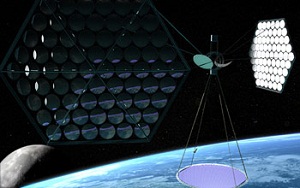Scientists say orbiting solar power stations feasible
 Maybe the headline should read, “Beam it down, Scotty!” As incredible as it may sound, within the next decade, huge, orbital photovoltaic satellite power stations could be beaming electricity down to the earth for humanity’s use. And such technology could satisfy the world’s¬¬¬ energy needs in 30 years. That’s according to a report from the National Space Society (NSS) and the International Academy of Astronauts released Nov. 14.
Maybe the headline should read, “Beam it down, Scotty!” As incredible as it may sound, within the next decade, huge, orbital photovoltaic satellite power stations could be beaming electricity down to the earth for humanity’s use. And such technology could satisfy the world’s¬¬¬ energy needs in 30 years. That’s according to a report from the National Space Society (NSS) and the International Academy of Astronauts released Nov. 14.
The three-year study shows the feasibility of gigantic photovoltaic arrays in space that could beam electricity back to the earth to power humanity’s needs, using technology that’s available today, according to NSS Executive Director Gary Barnhard.
“Space solar power doesn’t require new science. It’s one of those options that really does scale big. In terms of resources available to us, the sun is the best we’ve got,” he said.
The three-year study was conducted on behalf of 10 countries.
“There’s increasing interest from Japan, China, India, the European Union [and other countries],” said Barnhard, who is a robotics space systems engineer and has won multiple awards from NASA.
Such systems could provide base-load energy demand, according to Barnhard. They wouldn’t be unencumbered by weather and clouds, unlike earth-based PV systems, and would produce reliable, constant energy.
“[The report] offers up a smorgasbord of approaches among possible energy demand scenarios,” he said.
There are numerous ways to beam the power down to the earth, as well, Barnhard said.
“In the IAA report, they examined a number of technologies, microwaves, m-lasers [i.e., mid-infrared spectrum lasers] with diffusion so that there’s no weaponization,” he said. “Whatever transmission you use, you want to make it transparent to the atmosphere and safe.”
Even NASA, which conducted some of the initial research, but previously abandoned such ideas, is taking a second look.
“NASA, for the first time since about 2002 or 2003, now has an active study on this. So there is real work being done there as well,” Barnhard said.
While in the past numerous things were not yet possible to enable this technology to move forward, everything now is.
“There are workable problems that can make it part of the energy mix,” Barnhard said. “If we want to do it, we can build it.”
He said the report show that there’s a broad coalition of people engaging in moving these concepts to reality.
Image courtesy of the National Space Society via Mafic Studio, Inc.



